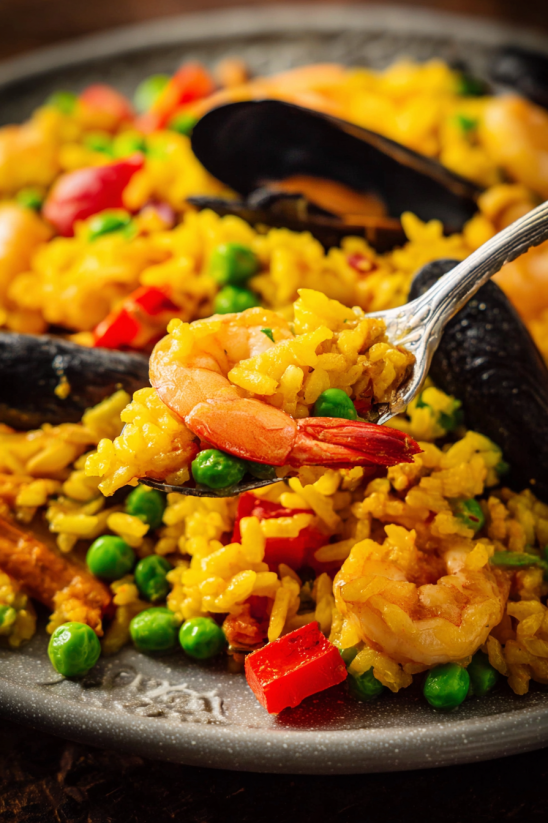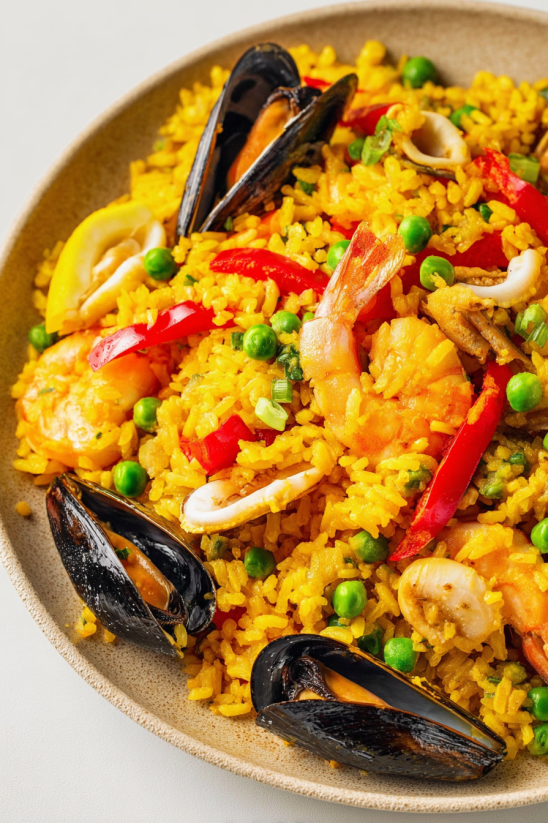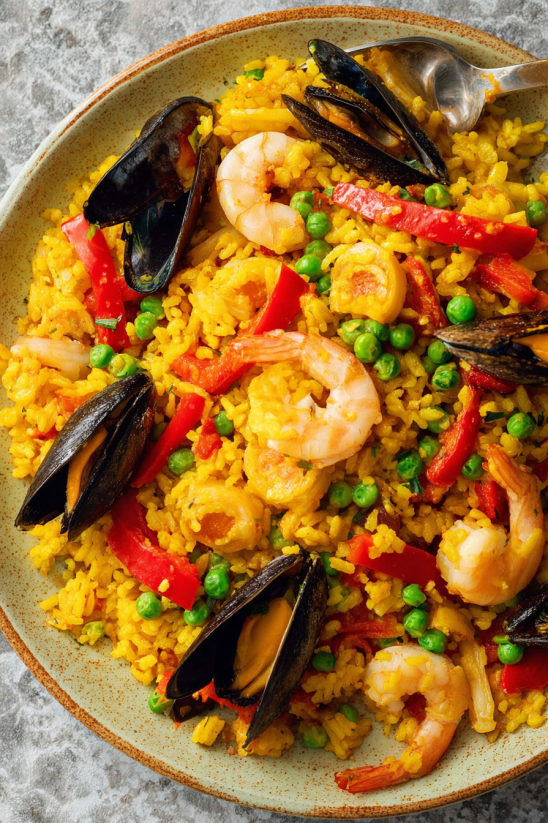 Save Pin
Save Pin
This seafood paella is an invitation to gather friends and family for a vibrant Spanish meal that feels special without fuss. You will get plump shrimp, briny mussels, and tender octopus all nestled in saffron-scented rice, with bursts of sweet bell pepper and peas. My husband and I always make this when we want something both comforting and celebratory.
The first time I made this paella for my parents they immediately asked for the recipe. Now it is our go-to for date nights at home or when friends pop over.
Ingredients
- Olive oil: Brings richness and helps all the vegetables and rice become silky and flavorful. Look for a golden hue and grassy aroma when selecting
- Garlic: Fresh cloves infuse deep savory flavor. Pick firm with smooth skin for best results
- Yellow onion: A sweet foundation for the rice. Choose onions with no soft spots or green shoots
- Red bell pepper: Adds color and natural sweetness. Look for glossy skin and firm flesh
- Frozen peas: Their bright color and sweet pop balance the seafood. Choose peas that are small and even in size
- Smoked paprika: Deepens the flavor with a gentle smokiness. Spanish paprika will give the most authentic touch
- Seafood bouillon or chicken bouillon: Boosts umami flavor. Pick a low sodium version if possible
- Saffron threads: Essential for earthy aroma and golden color. Select whole red threads that are uniform not yellowed
- Seafood or vegetable stock: Use a low sodium brand to control salt. Homemade stock is a treat but store-bought works well
- Dry white wine: Adds brightness and complexity. Use a wine you would enjoy drinking not sweet
- Paella rice: Bomba rice is traditional. Look for Spanish short or medium grain rice—it should feel hard not soft or cracked
- Shrimp: Choose large or medium uncooked shrimp with shells on for best flavor
- Mussels: Opt for fresh closed mussels or high-quality pre-cooked ones in the shell
- Octopus: Fresh or frozen Clean and slice into bite-sized pieces for easy eating. Squid is a good alternative
- Fresh parsley: Sprinkles bright herbal notes at the end. Select bunches with crisp leaves
- Lemon: Fresh wedges for serving pick juicy lemons with smooth skin
Step-by-Step Instructions
- Sauté the Aromatics:
- Begin by heating olive oil in a wide shallow pan over medium-high heat. Add chopped onion garlic and red bell pepper. Cook for about eight minutes stirring occasionally until the vegetables have softened and the onions are translucent and slightly golden. This builds the foundational flavor for the paella.
- Layer the Seasonings:
- Stir in smoked paprika saffron threads and seafood bouillon. Let the spices bloom for a minute until fragrant. This step infuses both the oil and veggies with rich color and aroma.
- Simmer the Rice:
- Pour in the seafood stock and dry white wine. Stir to combine and bring to a gentle boil. Scatter the paella rice evenly across the pan. Do not stir after this point. Lower the heat to a steady simmer and let the rice cook uncovered so the grains can absorb all the flavor while the bottom layer slowly toasts.
- Nestle in the Seafood:
- Arrange the shrimp mussels octopus and frozen peas on top of the simmering rice. Partially cover the pan using a lid or foil so the seafood steams gently without making the rice mushy. Cook until the shrimp turn pink and mussels have opened which should take about ten minutes.
- Create the Socarrat:
- Uncover the pan and increase the heat for just sixty seconds. This crisps the bottom layer of rice creating the prized socarrat. Watch carefully so it does not burn.
- Rest and Serve:
- Remove the pan from heat and cover completely. Let the paella rest for five minutes to finish steaming and absorb any remaining liquid. Serve directly from the pan garnished with lemon wedges and fresh parsley.
 Save Pin
Save Pin
Peeling fresh shrimp always reminds me of childhood weekends when my siblings and I helped in the kitchen. The citrusy aroma of the finished paella always fills our house with anticipation and brings everyone to the table.
Storage Tips
Seafood paella is best eaten fresh but leftovers keep in the refrigerator for up to two days covered tightly. Reheat gently on the stove with a splash of broth to keep rice from drying out. Avoid microwaving seafood for long to prevent a rubbery texture.
Ingredient Substitutions
If you cannot find Bomba rice Arborio is a suitable substitute. For more budget-friendly options use chicken instead of octopus and consider adding sliced chorizo for a smoky kick. Vegetable stock works if you want to make the dish entirely pescatarian.
 Save Pin
Save Pin
Serving Suggestions
Serve paella straight from the pan for a festive touch. Garnish with parsley and lemon wedges. It pairs beautifully with a simple green salad and crusty bread. For larger gatherings double the recipe and serve alongside Spanish tapas like olives and marinated peppers.
Cultural Context
Paella originated in Valencia Spain and was historically shared at large gatherings. The dish represents both abundance and hospitality. Today's seafood paella reflects the bounty of the Mediterranean and unites families and friends in celebration.
Commonly Asked Questions
- → What type of rice is best for seafood paella?
Short or medium-grain rice like Bomba or Calasparra works best since it absorbs liquid well and becomes tender without getting mushy. Arborio rice makes a good substitute if needed.
- → How do you achieve the crispy rice layer at the bottom?
Allow the rice to cook uncovered and avoid excessive stirring. In the final minutes, briefly turn up the heat to help toast the bottom and form socarrat, the coveted crispy rice crust.
- → Can I substitute the seafood?
Absolutely. While shrimp, mussels, and octopus are classic, clams, squid, or even a mix of your favorite shellfish can be used. Chicken and chorizo are popular variations as well.
- → What pan should I use if I don't have a traditional paella pan?
A large, shallow skillet with a flat surface (at least 12 inches wide) allows the rice to cook evenly. Avoid using a deep wok or pot to maintain authentic texture.
- → Why shouldn't you rinse the rice before cooking?
Rinsing removes excess starch, but for paella, you want starchy rice to help achieve the proper texture and create the crispy bottom layer.
- → Can leftovers be reheated?
Yes, leftover seafood paella can be reheated in a skillet over low heat to help retain moisture and texture. Add a splash of broth if needed.
